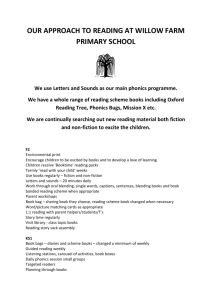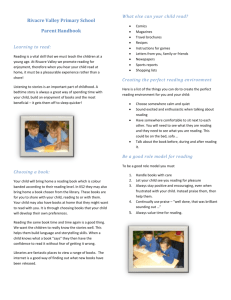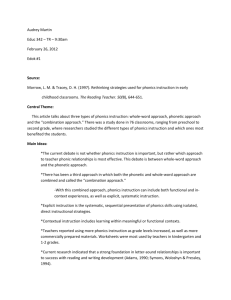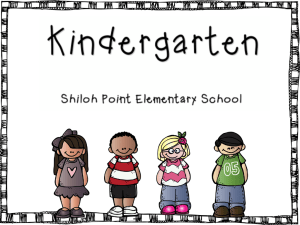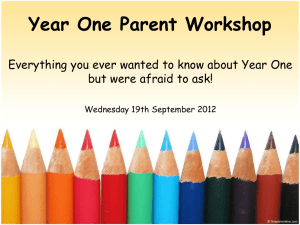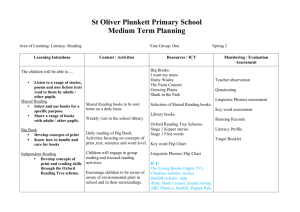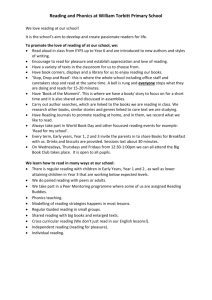In the 1960s, Chall researched reading methods to find the most
advertisement
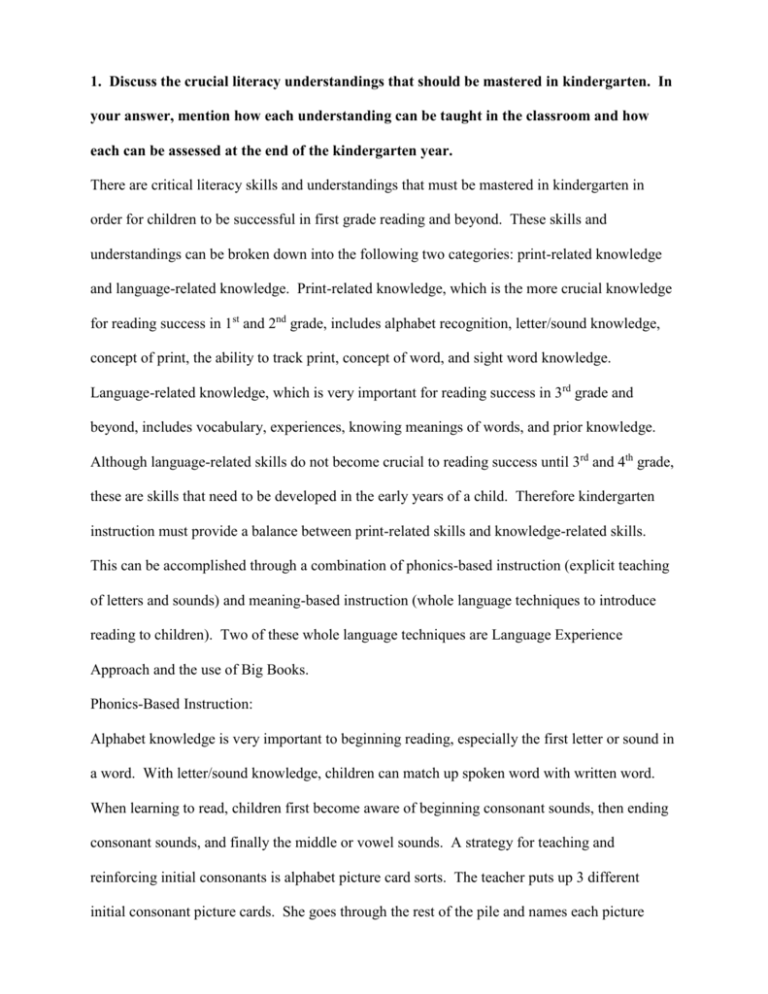
1. Discuss the crucial literacy understandings that should be mastered in kindergarten. In your answer, mention how each understanding can be taught in the classroom and how each can be assessed at the end of the kindergarten year. There are critical literacy skills and understandings that must be mastered in kindergarten in order for children to be successful in first grade reading and beyond. These skills and understandings can be broken down into the following two categories: print-related knowledge and language-related knowledge. Print-related knowledge, which is the more crucial knowledge for reading success in 1st and 2nd grade, includes alphabet recognition, letter/sound knowledge, concept of print, the ability to track print, concept of word, and sight word knowledge. Language-related knowledge, which is very important for reading success in 3rd grade and beyond, includes vocabulary, experiences, knowing meanings of words, and prior knowledge. Although language-related skills do not become crucial to reading success until 3rd and 4th grade, these are skills that need to be developed in the early years of a child. Therefore kindergarten instruction must provide a balance between print-related skills and knowledge-related skills. This can be accomplished through a combination of phonics-based instruction (explicit teaching of letters and sounds) and meaning-based instruction (whole language techniques to introduce reading to children). Two of these whole language techniques are Language Experience Approach and the use of Big Books. Phonics-Based Instruction: Alphabet knowledge is very important to beginning reading, especially the first letter or sound in a word. With letter/sound knowledge, children can match up spoken word with written word. When learning to read, children first become aware of beginning consonant sounds, then ending consonant sounds, and finally the middle or vowel sounds. A strategy for teaching and reinforcing initial consonants is alphabet picture card sorts. The teacher puts up 3 different initial consonant picture cards. She goes through the rest of the pile and names each picture aloud. Children work to sort the cards into pile by the initial consonant. Practice continues for several days until the skill is automatic. The teacher then places the letter above each picture and discusses the letter/sound match. Children repeat the activity to place the cards under the correct letter. Finally a spelling test is given. As each word is called out, children attempt to write the first letter of that word on their paper. Language Experience Approach: Day 1- The teacher arranges an experience that the whole class has together, and then the class discusses it and writes about it. The students dictate sentences that the teacher writes down and reads back to the class. The finished story id read chorally as the teacher finger points to each word. Day 2- The teacher rereads the story and the class choral reads again. The teacher asks questions like 1. Can you find this word in the story? 2. Can you find two words the same in the story? 3. Can someone come up and read this sentence? Day 3- Students are given a copy of the story with space to illustrate. While students are working on their drawings, the teacher can go around the room to check each child’s ability to read the story and track the print. Big Books: The teacher reads from a big book while finger pointing to each word. Children choral read with the teacher. The text is read again and again over the course of several days. The teacher asks questions like 1. What id this word? Let’s read and find out. 2. What is the dot/period for? 3. Can you find this word again in the story? 4. Can someone come up and read this sentence? As the year goes by, the amount of text in the stories should increase. Through repetition of these techniques, children will begin to develop alphabet knowledge, concept of word, concept of print, phonemic awareness, language skills, increased vocabulary through experiences, and sight word recognition. A simple assessment can be used at the end of kindergarten to measure mastery of skills. *Alphabet Knowledge- capital and lower case * Concept of Word- finger pointing to track print and identifying specific words in the text * Sight Word Recognition- list of 10 words: 5 sight words/5 decodable words * Phonemic Awareness- spelling a short list of words Spelling is a very natural way for children to demonstrate sound awareness. It is a window into what they know. For this reason, assessment information can also be gained from observing children writing and looking at their writing samples. 2. Explain the reasons for the rise of the Whole Language movement in the late 1980s, and the reasons for its demise in the late 1990s. How did Routman’s reading program attempt to meld whole language theory with traditional aspects of first-grade reading instruction? From your perspective, what were the strengths and weaknesses of her program? In the 1960s, Jeanne Chall researched reading methods to find the most effective. In 1967, Chall released her findings in Learning to Read: The Great Debate. She was among the first to describe learning to read as a developmental process and to advocate for the use of both phonics and exposure to challenging literature as the best method of teaching young children to read. She wrote that children learn to read in different ways, but the evidence points to phonics as the most important part of any reading program. By the 1970s and 1980s, based on Chall’s article, as well as other research at that time, basals had been revised to introduce all phonics skills in the first grade using strict word control. Teacher’s manuals became extremely long and detailed, often giving the teachers word-for-word what to say during instruction. Teachers were not happy with these changes. In the mid 1980s, psycholinguists Frank Smith and Kenneth Goodman began challenging basals as being boring and not representative of the language children have or use. They felt a reading program should consist of stories with rich, but natural language, no word control, no phonics, and no grouping of students. Teachers, fed up with the rigid structure of their current basals, quickly latched on to this new idea of whole language. In order to stay competitive, text book companies began creating basals with less word control and no phonics, containing stories with rich natural language. California was the first state to adopt the whole language program. Many other states followed suit. After about 8 years of learning through whole language, California students were given an achievement test, the NAPE. Results showed that California had dropped from 5th in the nation (on a previous test), to 47th in the nation. After such disastrous results, California was very quick to change their reading curriculum back to phonics-based instruction. By three years, whole language was out altogether. Routman was ahead of her time in seeing the need for a literacy program that incorporates whole language and phonics. She knew that children needed exposure to quality literature, but that quality literature alone would not turn her students into readers. She used quality literature for her whole group instruction, but still divided students into reading groups for differentiated instruction where she used guided reading and higher level questioning. The children were involved in shared reading through big books with an emphasis on listening, choral reading, finger pointing, concept of word, conventions, checking prior knowledge, predicting, and higher level questioning over literal questioning to promote thoughtful responses. Having familiar and favorite stories (poems, rhymes, etc.) read to them again and again, during a shared reading experience where they can see the text and see the teacher point to words as they are spoken, facilitates the learning of words and of letter/sound patterns, as well as an understanding of print and how it is read in English. Some phonics and word attack skills were taught in the whole group setting, like learning to use letter/sound cues along with prior knowledge and context to predict what a word might be. She also incorporated writing everyday with the use of invented spelling where students develop their own strategies for learning letter/sound patterns. When they can use letters to represent sounds, students begin to promote their own phonics development through writing. From my perspective her program had many strengths. Children were given lots of exposure to print through LEA, stories, big books, charts, and poems, they were writing stories or in journals every day, they had an uninterrupted block of language arts time, small reading groups were used for differentiated instruction, higher level questioning was used encouraging children to predict, analyze, apply, and evaluate, instilling a love of reading in a fun environment was a goal, some word attack strategies were taught, and children were taking home books to read. The main flaw I saw with Routman’s program was the lack of time spent on implicit phonics instruction. The small amount of time spent on phonics was done in a whole group, meaning every child received the phonics lesson whether they needed it or not, and whether they were ready for it or not. Phonics instruction during reading groups would have allowed for better meeting the needs of each child through differentiation. 3. What are the arguments for and against using reading groups in first grade? If you were teaching first grade and decided to group children for reading instruction, how would you organize your instruction (time and materials) to address the problems associated with ability grouping? One method of teaching reading in first grade is through the use of reading groups. As with any teaching method, there are pros and cons to using reading groups. On the positive side, reading groups allow for differentiation. Teachers can group students by ability and teach to their specific instructional levels. It is easier to provide for students when there is a smaller range of learner achievement. Also, time is set aside each day to observe and help individuals. Young children who are just beginning to read and write need the more direct approach provided by small group instruction. Without this close supervision, low-achieving children will fall through the cracks. In theory, ability grouping increases student achievement by reducing the range in student ability levels and this increases the likelihood that teachers can provide instruction that is neither too easy nor too hard for most students. The assumption is that ability grouping allows the teacher (1) to increase the pace and raise the level of instruction for high achievers, and (2) to provide more individual attention, repetition, and review for low achievers. The high achievers benefit from having to compete with one another, and the low achievers benefit from not having to compete with their more able peers. There are also several negative aspects of grouping students for reading instruction. The main problem for teachers is the overall management of small groups. It is much more difficult and time consuming to plan, prepare for, and teach 3 or 4 reading lessons a day, as opposed to just one lesson for whole group instruction. There is also the problem of providing appropriate, effective activities to occupy students when their reading group is not working with the teacher. From the student’s standpoint, there could be self-esteem issues involved with being a part of the “low” group. Another main argument against ability grouping is that the practice creates classes or groups of low achievers who are deprived of the example and stimulation provided by high achievers. Labeling students according to ability and assigning them to low-achievement groups may also communicate self-fulfilling low expectations. Further, groups with low performance often receive a lower quality of instruction than other groups. Also students may be tracked, or trapped in the “low” group throughout school, with no opportunity for advancement. If I were teaching first grade I would use small groups for reading instruction because I feel that the benefits outweigh the disadvantages. My organizational plan for successful ability grouping would include the following: 1. Students would identify primarily with a heterogeneous class. They would be regrouped by ability for reading instruction. 2. Grouping plans would be flexible and allow for frequent reassessment of student placement and for easy reassignment based on student progress. 3. The teacher will vary the level and pace of instruction, as well as the materials used, according to student levels of readiness and learning rates in regrouped classes. 4. Only a small number of groups would be formed in ability grouping. This will allow the teacher to provide adequate direct instruction for each group. 5. Groups will not be labeled with judgmental terminology (high group, medium group, low group). I would set aside at least 1 hour per day for small group instruction. The class would be split into three groups. The groups would rotate every 20 minutes through 3 stations. 1. Journal writing monitored by the teacher assistant 2. Literacy centers (ABC stamps, magnetic letters, whisper phones, listening station, etc.) and 3. Reading group with the teacher. A typical reading group lesson would consist of: *Choral reading of a familiar text and yesterday’s new book. Then buddy read or whisper read yesterday’s new book while teacher does running record on a few students. *Explicit word study/phonics lesson (beginning consonants, digraphs, blends, short vowel word families, etc.) based on the needs of the group. *Sentence writing- teacher dictates or students create (depending on the ability of the group) a sentence. Students try to write it, and then teacher writes it on the board. *Introduction of a new book which may include examples from word study/phonics lesson. Teacher does a picture walk, and then reads the story aloud. Students echo read. Students independently whisper read the new book. Teacher provides support as needed. Finally, students read the new book chorally to promote fluency.

